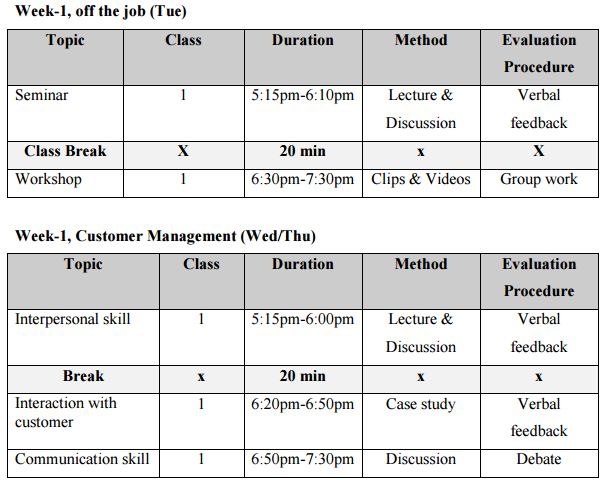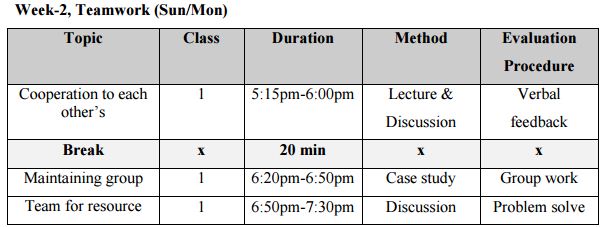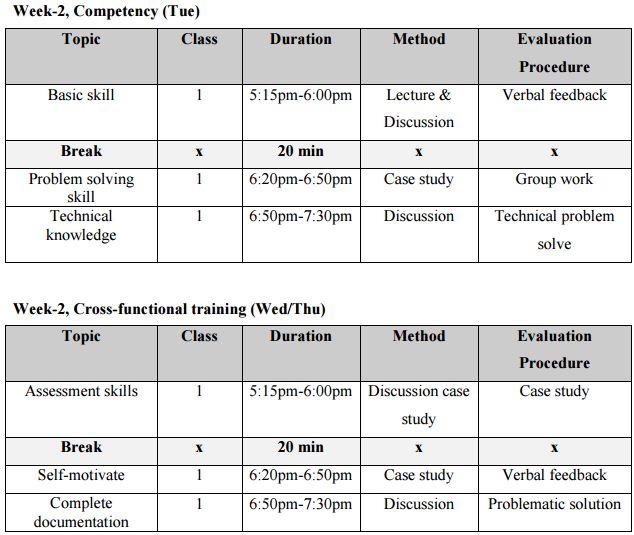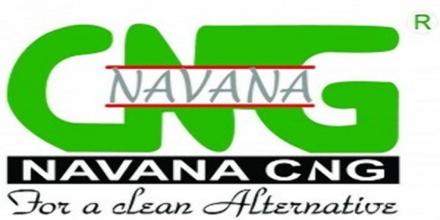Training and development program for increasing employees performance in
Navana CNG Limited
NAVANA GROUP is one of the most pioneer business organizations in our country. They are the introducer of the real estate business and CNG business in our country. NAVANA CNG Limited, a sister concern of NAVANA Group, is the leading CNG service provider in Bangladesh. These organizations have unique corporate culture and practices. They have a complete HR division and all the HR personnel are working together for ensuring more productivity, profitability and best use of their manpower.
The main objective of the study is to analyze and evaluate the training program of NAVANA CNG and also find out how training programs are increasing employees performance. In these report I cover the different training and development program. HR department design different training and development program based on the employees training need and deficiencies in the particular field. Navana generally follows the three phases of training and human development. They are Training needs identification, Program design & delivery and Impact analysis.
Objective of the Report
I have set our objective in the following way
Broad Objective
My main objective of preparing this report is to identify the problems to give proper solution about training and development program.
Specific Objectives
Firstly I want to find out what is training and development program and mainly focused on this issue, the research will go deep in this area to search details of the training programs that are practiced by the company and how help in increasing the employee’s performance in their designated job. So, in this report would be focused to find out how an organization links the training and development system with the performance appraisal.
The study is also undertaken with the following objectives:
- To find out the training need of different department employee.
- To develop different training and development program.
- To get an overall idea about the overall employee performance.
- How to implement the training program.
Methodology
The primary data had been collected in various ways. The different sources were:
Face to face conversations with the employees and opportunities were given by the management to work in relevant fields in NAVANA CNG.
- By interviewing different administrative officers of NAVANA group.
- Observing various organizational procedures.
- Secondary data were collected
- From prior research report
- From any information regarding the HR department.
- From different books and periodicals related to the NAVANA CNG
- From Annual Report and Internet.
Introduction:
Surveys indicate that training and staff development are the leading issues for most personnel departments. Staff training is an element in raising morale because it sounds out people for possible future promotions. The aim should be to train and develop each employee so far as possible even if that means running the risk of losing them to other organizations. This growing awareness of the importance of training and development over the past decades is also supported by reports that employees were spending more in aggregate terms on these activities. Technological developments and organizational change have gradually caused some employers to realize that success lie in the skills and abilities of their employees thus this means considerable and continuous investment in training and development. This has been brought to light by the rise in human resources management, with its emphasis on the importance of people and the skills they possess in enhancing organizational efficiency. Such human resource management concepts such as “commitment” to the company and the growth in the “quality” movement have promoted senior management teams to realize the increased importance of training, employee development and long term education intended to mean basic instruction in knowledge and skills designed to enable people to make the most of life in general. There has also been increased recognition of the need to complement the qualities of employees with the needs of the organization. Such concepts require not only careful planning but also greater emphasis on employee development.
About NAVANA CNG:
NAVANA CNG Limited, a sister concern of NAVANA Group, is the leading CNG service provider in Bangladesh. This organization have years of experience in standard setter of CNG industry. At present NAVANA CNG has around 900 personnel in various department and branches around the country.
NAVANA CNG Limited is the sole distributor of world famous CNG and LPG conversion kit manufacturer LANDIRENZO, s.p.a, Italy. NAVANA CNG Limited solely represents the renowned manufacturer of CNG re-fueling station technology Safe s.r.l, Italy. It has also collaboration with OMNITEK, USA for diesel driven vehicle conversion into CNG. For fast filling system NAVANA CNG represents WEH, Germany and OMB Saleri, Italy make products in Bangladesh. It has set up a modern CNG cylinder re-testing centre in collaboration with AirBlast S.A, Argentina. NAVANA CNG Limited has also collaboration with NGV Motori, Italy for disel driven Generator conversion into diesel gas system. At present, NAVANA CNG Limited is running nine conversion workshops located at various locations in Bangladesh five of them are at Dhaka, two are at Chittagong and the remaining two are at Sylhet and Bogra.
Services of NAVANA CNG Limited:
NAVANA CNG provides the following services:
- Petrol /Octane driven vehicle conversion into CNG.
- Diesel driven vehicle conversion into CNG.
- Diesel Generator conversion into Diesel Gas System.
- Selling gas through CNG re-fueling station.
- Selling CNG re-fueling station on turn-key basis.
- Selling CNG conversion kit, cylinder, and cylinder shut-off valve and re-fueling nozzle, receptacle etc.
- Offering package maintenance program for CNG re-fueling station.
- CNG cylinder Re-testing facility.
- Providing training on CNG conversion and re-fueling station.
CNG Refueling Station:
NAVANA CNG has been collaborated with world famous Safe s.r.l, Italy for the operation of CNG re-fueling station and working as a sole distributor for marketing of Safe s.r.l, Italy make CNG compressor. NAVANA CNG installed its first CNG re-fueling station in February 2003. Now NAVANA CNG uses two types of compressor for setting up of CNG re-fueling station, one is electric driven compressor and the other is gas driven compressor. At present NAVANA CNG has captured more than 50 % market share in Bangladesh by selling and installing CNG refueling stations to the various customers and 17 nos. of own operating CNG re-fueling stations in all over Bangladesh. NAVANA CNG provides all kinds of support for installation and commissioning of CNG re-fueling station and 24 hours backup service by well-trained maintenance team to the customers.
Additional features of CNG refueling station:
- Gas engine/ Electric motor driven compressor.
- Chiller for increasing filled gas quantity.
- Low maintenance cost.
- 24 hours maintenance service.
- Low electric consumption.
- Bus filling technology.
- Exclusive 4 nozzles dispenser.
- Automatic billing system.
- Fast filling nozzle.
- Longer life for all moving parts.
- Well trained engineers from Italy.
Cylinder Retesting Facility:
NAVANA CNG started as the first government approved CNG cylinder re-testing centre in Bangladesh in private sector. According to the recommendation of cylinder manufacturer, cylinder re-testing is required in every five years from cylinder manufacturing date to ensure 100% safety of using CNG cylinder. NAVANA CNG cylinder re-testing centre is equipped with the most modern and computerized machines which are supplied and supported by world renowned company AirBlast, Argentina. Most of the engineers and technicians of NAVANA CNG Limited are skilled and well trained by Air Blast, Argentina, who are working in this retesting centre.
Why CNG Cylinder re-testing is required?
- To ensure 100 % safety of using CNG cylinder.
When Cylinder re-testing is required?
- After every 5 years from the date of manufacturing.
Diesel Driven Vehicle Conversion into CNG:
Diesel driven vehicle conversion into CNG is one of the fastest growing business sector in Bangladesh. NAVANA CNG Limited started conversion of diesel driven vehicle into CNG on 22nd June, 2004 by converting a HINO – FB2W mini bus. NAVANA CNG uses two types of system for diesel driven vehicle conversion into CNG, one is the Traditional Distributor System and the other is Electronic Ignition System of Omnitek Engineering Corporation, USA. This system is the world’s number one system for retro-fitment and NAVANA CNG is the sole distributor of this product. This system ensures minimum gas consumption and quick pick-up with optimum power. Vehicle will be auto tuned depending on engine load, temperature and R.P.M Microprocessor always monitors engine by different types of sensors.
Dipnagar workshop, which is dedicated for diesel driven vehicle conversion, has emerged as the largest diesel-CNG conversion workshop in the country. NAVANA CNG has already converted more than 1000 diesel vehicles of all brands like Hino, Isuzu, Tata, Ashok-Leyland, Toyota, Bedford etc. into CNG and all of these with utmost satisfaction of our customers’. Additional features of diesel Driven Vehicle Conversion into CNG :
- Conversion and after sales services in Dhaka, Chittagong, Sylhet & Bogra.
- Availability of spare parts is guaranteed.
- Well trained engineers and technicians.
- Highest experience in diesel driven vehicle conversion into CNG.
- Latest technology.
Diesel generator conversion into diesel gas system:
As a pioneer of CNG industry in Bangladesh NAVANA CNG Limited has started its latest project for conversion of diesel generator into Diesel Gas System. On 10th June 2008, NAVANA CNG started diesel generator conversion by converting a 250 KVA CUMMINS, India and a 50 KVA KOHLER, USA make diesel generator into Diesel Gas System. NAVANA CNG has been collaborated with world renowned CNG kit manufacturer NGV motoring, Italy for converting diesel generator into Diesel Gas System and working as an exclusive distributor of NGV motoring in Bangladesh.
Additional features of diesel generator conversion into diesel gas system:
- Can be operated by Diesel or Diesel Gas System.
- Reduce fuel cost up to 60 %.
- ECU controlled system.
- Low maintenance require than gas generator.
- No major changes in the basic generator configuration.
- Well trained engineers from NGV motori, Italy.
- No loss of power after conversion.
- Noise level remains almost same with original features after conversion.
- No chance of injector blocking.
Vehicle Fitness Checkup Station:
To ensure best performance from vehicle, certain parts and systems of vehicles have to be checked at certain intervals as vehicle has thousands of moving parts, which are working together and by normal driving over time, some of these parts simply wear out or no longer perform the way they should.
Proper and periodic fitness checkup of vehicle is the best way to reduce the chances of unexpected breakdown and costly repair. To check more in-depth of vehicle, NAVANA CNG offers a complete vehicle fitness checkup facility including hands-on inspection of the brake performance, suspension, sideslip, engine power, headlight and exhaust emission which ensure long life of your vehicle without any trouble.
Additional features of Vehicle Fitness Checkup Station:
- Better engine performance ensures less fuel consumption & better emission and reduces the chances of major engine breakdown.
- Ensures better brake performance in maximum load condition with proper control on vehicle.
- Ensures better suspension performance of vehicle to ensure comfortable journey of users.
- To ensure proper wheel alignment for vehicle turning to reduce wear & tear of vehicle tire.
- Increases engine performance by testing smoke emission.
- Reduces harmful exhaust emission which is produced during combustion.
- Appropriate focus of head light ensures proper driving and reduces the chances of accident.
- To measure the sound level and reduce sound pollution from environmental aspect.
Training and Development Program:
Training refers to the process of teaching or giving new or present employees the basic skills that is required for their current job. Employees have to know what the employer wants them to do and how to do those tasks and training is vital to know and perform their best in the present job.
On the other hand, Development refers to the process that provides employee knowledge, skills and attitudes they will need to perform jobs they aspire to in future.
Training and Human Resource Management (HRM)
Human Resource (HR) department is the one under which training and development programs are being carried out. Along with other HR functions training and development has become equally a vital component. Those days had gone, when training was considered to be futile, waste of time, resources, and money. Now-a-days, training is an investment because the departments such as, marketing & sales, HR, production, finance, etc. depends on training for its survival. NAVANA also beliefs training is a great investment and weapons against less productivity. So in order to carry out the successful HRM activities, organization needs to have effective training and development system to update employees’ skills and knowledge according to the needs of business. This would motivate employees to accomplish the organizational goals and thus increase their job satisfaction level.
In the past, training and development program was used to focus mostly on technical skills for factory workers or for people working for manufacturing companies. Today, such technical training is not enough. Companies need to get adapted to new technological change, develop new products, provide better service quality and boost productivity in order to remain competitive.
Moreover, employees need skills in team building, decision making, communication, technology, computer etc. Besides, they sometimes need to sit with the top management and identify the skills and knowledge required to achieve the strategic goals and objectives of the company. Sometimes employers take some steps for future development of the employees. These development programs may not help them in their present job but in future these employees will be turned as company’s assets and play a vital role in betterment and increasing productivity of the company.
Navana generally follows the three phases of training and human development-
1) Training needs identification
2) Program design & delivery
3) Impact analysis
Training needs identification:
The company identifies whether the employees need training or not, whether they are efficient or not in performing their job effectively and efficiently. Moreover, if the company makes a huge profit in any of the year of its operation, employees may need training as their performance may not be up to the level. Again, employees may be efficient, but may not work well as they are not well-informed about the task they are required to perform. Generally, we look at the company’s performance rather than the employee’s performance. But the employee’s performance that is achieved through training reflects the company’s performance. Company provides training and development program to its employees. Besides, these assets play a vital role in improving and increasing productivity. Besides, the organisation analyses the training needs of its employees through the analysis given below:
a) Gap Analysis
b) Behavioural Analysis
c) Functional Analysis
d) Organisational requirements
(a) Gap Analysis
All employees cannot equally perform, they sometimes lack of knowledge, skills, efficiency in decision-making etc. today, and job has become complex and employees need to know all the tasks of their and others tasks and work team wise. Employees who lack required skills and knowledge are identified and are provided with training program.
(b) Behavioural Analysis
Behaviour, attitudes, culture, working pattern of each employees are different. For this the organisation identifies those employees who works for the department latter and provides training and development program to improve their performance. Moreover, they have to work individually or in a team that are enhanced by means of teams based training.
(c) Functional Analysis
The company lists the specific duties and skills required to perform the job and observe whether the employees can perform the duties effectively and efficiently or not, whether they possess the required skills or not. The supervisors report their observation in the managerial level and the selected employees are provided with the training.
(d) Organisational Requirements
Employees need to know the mission, vision, objectives and goals of the company. They must understand their job and the company objective very well. The employees should know what the
company wants them to do and how their performance will impact on the company objective.
The organisation provides training program to its valuable employees in order to let them know the company requirements.
Program design & delivery
The organisation generally forms a team which designs and implements the training and development program. The team divides the employees into groups and designs program according to their needs. It sets the duration, timing and the specific training program for a certain number of employees and implements according to the design. For example, workshop workers are provided with training that improves their skills, helps them to increase and improve their production quality and perform their best. Again, employees in marketing, finance, management information system are also provided with relevant training and development program to improve their performance in their current and future job.
Selecting & dividing employees who need training:
Training and development team designs and offers those to various departments, and then each department identifies the employees who need training. The line managers, supervisors and other people from mid-level management select the appropriate training program for the appropriate employee. Sometimes department gives options about various training programs to the employees and from them employees decide to have specific training and development programs based on their needs. An individual knows himself/herself best for which if he/she gets involved in identifying own training needs, then the true developments can come out. So, we encourage its employees to select their own training programs from the options.
Implementing the training program:
Training & development program is arranged and provided according to the number of employees, types and duration of the program. Recently conducted 14 days training program in given below:




Impact analysis
One of the most important phases in the training and development program is analysing the impact of the program on the trainee. In this case, the team and the supervisor evaluate the performance and their improvement of the trainees. They call for informal and formal interview to the employees and analyse whether the training program was beneficiary to them or not. They try to find out the performance of the employees after the training is up to the expected level or not. According to the findings, the team as well as the supervisor take further steps in human resource management and development.
Follow two methods to evaluate the training of their employees
- Written test method.
- Feedback method.
Here are the brief descriptions of these two methods:
Written test method
As the name refers, written test is the evaluation method, where the validity or the adoptability of the trainees is measured in form of answering some kind of questions in written form. It can be like essay type question, multiple choice question etc.
If an organization will be follow essay type questions and multiple choice questions as the evaluation method to see if the employees are getting the trainings or not. So, by going through the test scripts, the trainer or the employer gets to know about the employees, or the trainees, regarding their learning from the training programs.
Feedback method
Unlike the written test method, feedback method is practiced after the training period and through the job. It is like, getting the employee feedback about the training they just came through and the assignments they are being given to perform according to the training. Are they having any kind of trouble matching the training experiences and the real life job experiences, are they showing any extra potential than any other employees and everything.
After Evaluation Follow-ups:
After all the training programs and evaluating the trained employees, we will some after evaluation follow ups. Here, supervisors set some kind of performance standards and measure the employees’ performance according to the standard and actions are taken accordingly.
If they found someone doing better than the standard level, they will be appraised. Those who perform below the standard level after the training, they would be trained again in the next session.
If they find some trained employees, doing better or their performance is higher than the preset standard level, those employees will be marked and they might be considered at the succession planning in an organization. If they found someone doing better than the standard level, they will be appraised. Those who perform below the standard level after the training, they would be trained again in the next session.
If any trained employees are found performing according to the standard level, it will be considered as a result of successful training. And they may be marked for some kind of advanced level training later on.
Finally regarding the follow-ups after the evaluation, it can be concluded by saying that if they find some trained employees performing below the standard performance level, they will be screened and they will be kept for training. They would be considered for the next training session, because, they did not adopt the training in perfect manner.
Observed in the Organization
This report covers an existing training & development system that has been observed in the last six months. The findings of this report describe the tasks that take place in the HR Department of NAVANA CNG limited. Here I mainly focused on the problems of the some inter division of the NAVANA CNG limited which findings are completely from my personal point of view. Those are given below:
- Employee turnover rate is high sometimes because in the last few years many new CNG service providers come in the market and the new comers offer very high salary and incentives to hire NAVANA’s employee.
- NCL is not fully IT based organization. Only the billing department is it based.
- Internal control policy is not productive at NCL.
- There is lack of awareness about talent management.
- Awareness of culture is misplaced at NCL. For example, in the restaurants sometimes no alternative menu for some other religion people.
Academic Preparation:
After completing Bachelor in Business administration I did my internship is such a wonderful organization which provided lot of experience about the real business world. Doing my internship at NAVANA CNG Ltd is well organized and cordial branch to help internship student a lot. After working in a professional life I can understand one thing very clearly that is academic life and job life is totally different to each other. Whatever we study so far in our academic preparation is not so much related to our practical job life.
Though I did my minor in HR, subject course is little bit relevant to our job sector because I am working in the HR Dept. which is fully HR environment. Besides that, Training & Development, Performance Management courses are little bit helpful to me. But some sort of case, I did not properly execute this course material to my job sector. Lacking of revision this course I was fail to execute this course. Our HR courses were pretty relevant to my working sector. BRAC University provides those proper guidance and discipline and nurturing ourselves that helps us to good performance in our job field.
Recommendation:
Although according to NAVANA CNG LTD. running normally, but some lacking have been found by analyzing the company’s weaknesses which include de-motivation of employees that increased the turnover rate of the company. So, like this there are other reasons for which the training and development system of NAVANA CNG LTD. cannot be said as fully appropriate to increase the performance level of its employees. Hence, some of the lacking of the training system is discussed below:
- After undergoing the training program the trainees should be motivated to stay by providing them incentives.
- The organization should gradually be fully facilitated by IT packages.
- The internal control policy should be more extensive and more effective.
- The training and development program does not include job rotation. This is depriving the employees from achieving greater task variety. For any employee, it is important to know how the other departments work if that employee has to understand the particular department that the employee belongs to better.
- The current training and development program lacks situation analysis based training where employees are given real life situations that test how good or efficient employees are in handling real life problems. So the absence of training like this fails to prepare employees for uncertain and unexpected situations.
Conclusion:
NAVANA CNG LTD. is known as one of the leading company among the local companies. According to their mission they are committed towards providing good quality service to increase the satisfaction level of its customers. It also mentioned that this would be done by means of is productive and efficient employees.
In order to fulfill this mission NAVANA CNG LTD. will be making their employees as competitive advantage which can be done by proper training. This training would not only help employees to be productive in their present job, but also by means of development programs like competency based training are increasing the potentiality of the employees to perform future job.
The effectiveness of these training programs is not only ensured by the proper evaluation but they are also linking it with the succession planning which are done for the employees who outperform after having training.
However, it was also found after analyzing, some lacking is found in the company’s training and development system. In order to overcome these lacking, some recommendation has been made. Nevertheless, as business environment is getting competitive day by day, NAVANA CNG LTD. will be trying to align itself and its employees with the global business changes. This can be done by providing of training that would facilitate employees to gain new knowledge and skills.
















